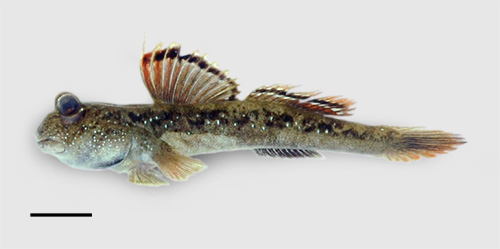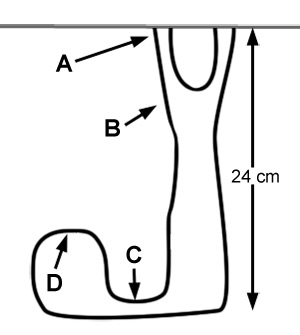|
Common names:
China, Zhuhai |
Cantonese |
(gun tsoi deng - Nail of coffin) |
China |
Mandarin |
(da qi tan tu yu - Big-finned Mudskipper) |
Italy |
Italian |
perioftalmo dalla grande pinna* |
Korea |
Korean |
큰볏말뚝망둥어 |
* proposed name
|
|
|
Synonyms:
Etymology:
'Periophthalmus' is a compound name from the Greek 'peri' (around), and 'ophthalmôn' (eye), which refers to the wide
visual field of these species
'magnuspinnatus' is a compound name from two Latin adjectives: 'magnus', which means 'large', and 'pinnatus',
meaning 'which have fins'. The name refers to the large first dorsal fin of this species
(Lee et al., 1995).
It is worth noting that since only the second adjective is referring to the fish, the compound adjective should have been
'magnipinnatus', using the 'i' as a connecting vowel between the adjectives, just like the English form 'big-finned',
where the hyphen has the same function. Nonetheless, according to the ICZN (3d ed.), if not "inadverted", an incorrectly formed name
is not to be corrected (Artt. 32.2; 32.5.1)
|
Maximum recorded length:
90 mm SL (Lee et al., 1995)
Live colouration
(Lee et al., 1995;
Baeck et al., 2008;
photos: pers. obs.: southern China, Bohai Sea):
background colour light brown, with sky blue spots on cheeks, opercula, and flanks, more numerous on head; head
and body ventrally whitish; opercular margins ventrally darkened; 4-8 diagonal dark brown and irregular bars are frequently visible along flanks; D1 reddish-brown with a black inframarginal stripe and a narrow, paler to transparent margin. D2 proximally reddish-brown with a broad inframarginal black stripe, sandwiched between a narrow transparent stripe and a wide reddish margin; pectoral fins dusky; caudal fin dusky, proximally darker; anal fin blackish; pelvic fins ventrally dusky, dorsally dusky to blackish
Colouration on preservation
(Baeck et al., 2008; pers. obs.: southern China):
ground colour brownish-grey on dorsum and flanks, ventrally paler; the pale speckles on head may be preserved; opercular margins ventrally darkened; D1 dark grey, proximally darker,
with a broad black inframarginal stripe and a hyaline margin;
D2 hyaline, proximally dark grey, with a broad black inframarginal stripe and a hyaline margin; pectoral fins dusky; caudal fin dusky, medially darker; anal fin blackish; pelvic fins dorsally and ventrally pigmented, more intensely on the dorsal side, and with a paler margin
Diagnosis (Lee et al., 1995; Baeck et al., 2008):
D1 XI-XIII; total D2 elements 13; total anal fin elements 12-13; longitudinal scale count 86-90; predorsal scale count 31-32; length of D1 base 25.2-30.3%SL; height of D1 greater than body depth; first two spines of D1 slightly elongated; pelvic fins only partially united by a basal membrane, and with a prominent frenum uniting the two spines; D1 with no spots and a broad dark submarginal band; dorsal fins not connected by membrane; caudal fin broad and rounded; sky blue speckles on head and flanks.
The genus is yet undefined by synapomorphies
Diet:
carnivorous, opportunistic, apparently only gape-limited (crabs and other benthos: Baeck et al., 2008)
|
|
Reproduction (south Korea):
in south Korea the breeding season is from early May to July (Baeck
et al., 2008). Reproductive males dig burrows on elevated and sloped intertidal mud deposits, covered by halophytic grasses. To attract females, they darken their bodies and make vertical jumps with the spread fins. When the female approaches, the male
induces her to enter the
burrow by rapid, quivering movements (Baeck et al., 2008). Reproductive burrows have 2 openings with slightly raised edges: the two diagonal shafts fuse into a larger vertical shaft; this one turns into a horizontal shaft, which ends into a dome shaped chamber, where the eggs
are spawn.
Then the female leaves the nest, and the male guards the eggs and maintains an air phase inside the egg chamber (Baeck et al., 2008)
middle: diagrammatic drawing of a reproductive burrow of P. magnuspinnatus (redrawn from Baeck et al., 2008; A: openings; B: the two short diagonal shafts fuse into the larger vertical shaft; C: horizontal shaft; D: ceiling of the egg chamber, where the eggs are laid)
|
|
|
|
Ecological notes (south Korea):
this species is distributed in the mid-higher intertidal zone, on vegetated mud deposits. P. magnuspinnatus is distributed in temperate regions, and it hybernates during winter, remaining inside burrows. In south Korea, P. magnuspinnatus is active from late April to early September, having a slightly shorter active season than the sympatric P. modestus (Baeck et al., 2008).
Contrary to P. modestus, it seems that P. magnuspinnatus permanently occupies and maintains its burrow during the whole active season (Baeck et al., 2008). When P. magnuspinnatus coexists with P. modestus, this latter species is usually distributed at lower intertidal levels (Baeck et al., 2008).
|
|
|
|
Distribution (Lee et al., 1995; Wang et al., 2006):
from south Korea, southward to the South China Sea;
type locality: Hodu-ri, Haeryong-myon, Sungju-gun, Chollanam-do, south Korea
|
|
|
Remarks:
In China, P. magnuspinnatus was confused with P. modestus for a long time after its description from south Korea (Lee et al., 1995). A molecular study (Wang et al., 2006) verified the presence of both species in China (Bohai, Yellow, East China and South China Seas)
|
Photographs of Periophthalmus magnuspinnatus:
|
|
A: specimen of P. magnuspinnatus (photo: Kim I.-S., 1997, on fishbase); B-D: some specimens in nature (photo: R. Cui, Guandong, China, 2006)*; E-F: close-ups (photo: R. Cui, Guandong, China, 2006)*; G: another close-up with some details of dorsal fins (photo: M. Endruweit, Qingdao, China, 2008)*; H: two aggressively interacting males (photo: M. Endruweit, estuaries west of Qingdao city, towards Huangdao, 2009)* - * with permission
|
Drawings of Periophthalmus magnuspinnatus:
left: cephalic sensory and nasal pores of Periophthalmus spp.: an= anterior nostril; pn= posterior nostril
(modified from Murdy, 1989)* - * with permission
|






![]()